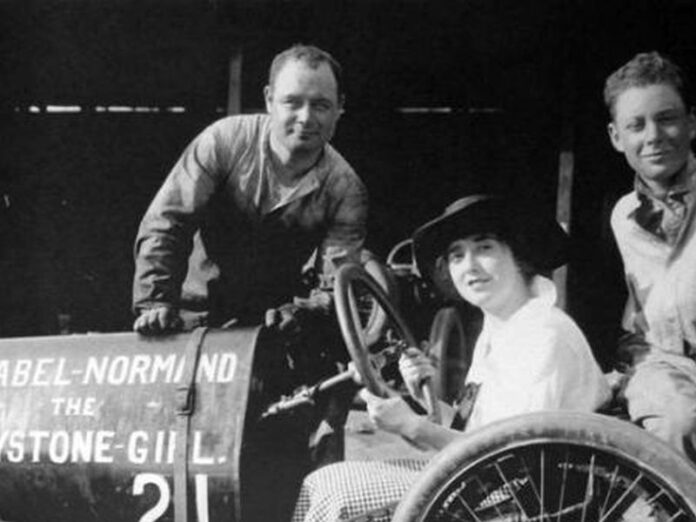Last night I dreamt I went to East Lynne again… Ellen Wood is directing my subconscious now. I love this mini melodrama strand and I really enjoyed today’s instalment, which was the lavish 1925 Fox adaptation, East Lynne (Emmett Flynn), scripted by Lenore Coffee and starring Edmund Lowe as Carlyle and Alma Rubens as Lady Isabel – a very handsome pair and just right for this ill-starred pair.
This film is a smart adaptation, which changes the plot but not the story, though somehow manages to present itself as having a Hollywood happy ending – I won’t give away how. Yes, Levison (Lou Tellegen) goes in the pond, and we see the rail crash, though some other scenes (no slap from Lady Moun t-Severn) and babies go astray. The murder of Afy’s father is very good, and it was excellent to see Belle “Stella Dallas” Bennett as Afy, no better than she ought to be. Levison was a sexy villain just as he should be. Cornelia (Martha Mattoz) was more of a comic character than a harridan, flirting with Mr Dill and doing terrible things to her harp, and we appreciated the light relief. Which brings me to the music. As ever Stephen Horne and Elizabeth0Jane Baldry proved a simpatico duo, creating some lovely pastoral moods and Parisian atmosphere. A special mention must go to Elizabeth-Jane though for gamely replicating Cornelia’s string abuse, in amongst her gentler, more expressive and soothing approaches to the harp.
East Lynne was preceded by a sliver of melodrama wrapped up in a meta-comedy. L’Illustre Attrice Cicala Formica (Lucio D’ambra, 1920) was an Italian film about a young woman (Lia Formia) who dreams of being a movie star. She persuades/forces her friends, family and staff to become cast and crew and awaits her closeup. At the premiere she is mortified to find that the film was recorded with the handle (upside down) and now the film is entirely composed of backwards actions. The cinema does not always glorify its subjects, it can present them in alienated, abstract form, image and movement without sense. She has encountered the avant-garde! This was fun, slight, and felt to me like it could really have a been a Soviet comedy, in another universe, although the style was entirely Italian. Charming accompaniment for the pretentions of grandeur and the comeuppance both by Neil Brand.
After lunch we were back in Chaplinland, following a snippet of conversation between Jay Weissberg and David Robinson about the latter’s first memories of the Little Tramp. All of these films were accompanied brilliantly by Meg Morley, and they were a mixed bag of styles indeed. My favourite of this selection of Chaplin’s distaff influences was Betty Becomes a Maid (1911), starring Mabel Normand as a pretty young thing determined to snare a man even in disguise as the help. Some great hairpin action here as her sister (Evangeline Blaisdell) takes out her frustrations on Betty ringlets. Normand is a total natural in front of the camera, here at the start of her career: a winning smile and nonchalant comic timing. Just a total delight. And Mabel returned in a film she co-directed with Mack Sennett, Mabel at the Wheel, a 1914 raceground romp featuring a young toff with a villainous bent and very strange facial hair. Charlie Chaplin himself in an early incarnation – the same tricks play very differently without the winsome air of the underdog attached to the Tramp.
This was followed by Chaplin in cartoon form, punished by electric currents and sent into a mindflip of a volt-dream in Charley’s Electrishes Droom (John C. Terry, Hugh M. Shields, 1916), while line-drawn Mabel and Roscoe watch, and Morley conjured some suitably wild sounds. Another of Chaplin’s early female co-stars took the lead in a frankly bizarre film, Tillie’s Tomato Surprise (Howell Hansel, 1915), featuring Marie Dressler as a woman vying for an inheritance and accompanied by a monkey and by a mysterious inventor known as the Bat (Colin Campbell). Who flies of course. Our final film in this programme, The Vilain (Arvid E. Gillstrom, 1917) featured a fake Chaplin (Billy West, who made a career out of it) and Oliver Hardy in a dress… ah, say no more. The stage was set for the later afternoon film, which was Harold Lloyd channelling the essence of Charlie in Lonesome Luke in Tin Can Alley (Hal Roach, 1917).
I finished my day with presentations on three entirely disparate books. I will not test your patience by trying to pretend I have a clever link to unite them. Peter Domankiewicz presented the book her co-authored with Barry Anthony and Deac Russell, Finding Birt Acres: Rediscovery of a Film Pioneer (Exeter). Which seems as exhaustively researched and comprehensively revelatory as you would expect. Vito Adriaensens’s Velvet Curtain and Gilded Frames (EUP) has the best title of any book at this festival and explores the influence of painting, photography and pictorialism on European feature films of the 1910s. I take little persuading on this thesis and the examples shown in his presentation spoke for themselves, as well as being very beautiful. Another beauty, the first Mubi book publication, Read Frame Type Screen: Or, Written on the Film by film curator Enrico Camporesi, graphic design historian Catherine de Smet, and designer Philippe Millot, was presented by Caitlin Quinlan. Excited to see this innovatively designed gem in person. Oh, OK, I found a link between the books: they all invite you to look at film one frame at a time. To stop the projector. Which is appropriate, as I am going to bed.
Intertitle of the Day
“I don’t care. I’m pretty anyway.” Honestly Mabel Normand, this attitude will get you far in life. That’s Betty Becomes a Maid.
Overused symbolism of the Day
An apple a day keeps monogamy away in East Lynne (1925)
- Espresso habit may be under control. but how much caffeine is in a square of Peratoner chocolate?
- Sine Nomine. Can you help identify an unidentified silent film?
- You can read more about the festival, and all of the films, on the Giornate website.
- I am on Letterboxd – watch me struggle to keep up with all these films.
- Silent London will always be free to all readers. If you enjoy checking in with the site, including reports from silent film festivals, features and reviews, please consider shouting me a coffee on my Ko-Fi page.



